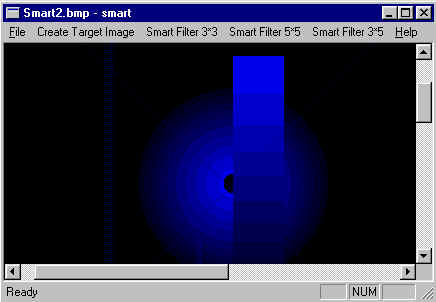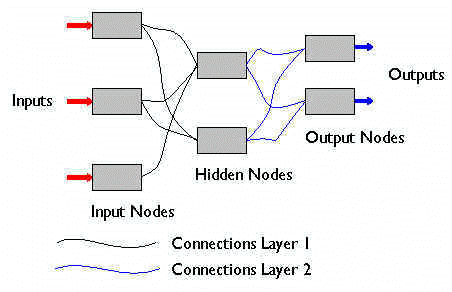
Neural and Genetic Imaging

The neural imaging / image classification library
provides both established evaluation methods and the most up to date techniques.
These include:
- Advanced Pattern Recognition
- Fuzzy Logic
- Functional Link Neural Networks
- Multilayer Neural Networks
- Smart Filters
- Statistics Library
This highly structured software library enables
the rapid development of real time neural image inspection systems. The
statistics library has an equivalent functionality to commercial statistics
packages. ILIB3 is a library for the serious developer who builds intelligent
systems for real time performance.
°@
ILIB3 is for people who need to develop demanding imaging applications or who are engaged in research. It allows you to build practical neural imaging applications that can include fuzzy logic and advanced pattern recognition techniques. A full statistics library is included, which means you can keep track of the results or monitor industrial production quality.
°@
Neural Imaging
ILIB3 is for classification of image data and includes neural networks, smart
filters and other techniques. We have drawn on our experience of designing
medical, scientific and industrial imaging systems in selecting an extensive
list of functions. ILIB3 is at the leading edge of practical imaging systems
development.
The neural networks allow you to build practical imaging systems which
incorporate machine learning. The neural approach may also be combined with
ILIB3°¶s pattern recognition and fuzzy logic. The statistics library enables
monitoring and quality assurance for manufacturing in addition to its uses in
research and development.
Simple Neural Network Structure

The Neural Imaging Library includes:
Single and Multi-Layer Neural Net Structures: User configurable masked standard and functional link nets; bias nodes; single and multiple pattern classification functions; single and multiple pattern training; training pattern randomisation; fixed and variable training rates; supplied or user defined activation functions; data clustering; neural net dynamic creation and removal; multiple and current neural nets; net structure validation; dynamic net internal memory allocation; training or prediction data to or from disk files or real time; storage and retrieval of net structure and weights from disk; target pattern disk files.
Neural Net Utilities: City block classification; Euclidean classification; square distance classification; neural network structure operators; neural net file operators; get and set class type; get and set class identifiers; get and set class vector; get and set clustering maximum; get delta value(s); get and set pattern feature; get and set net and data file names; get and set level of network interaction with user; get and set training iteration limit; get and set maximum training error; get and set momentum; get and set lambda; get and set individual net names; get and set number of classes; get number of features or functional features; get number of layers; get and set number of nodes in layer; get and set number of training and prediction patterns; get and set outputs; get and set pattern; get and set prediction index limits; train or retrain; get and set net; get and set squashing function type; get and set squashing function; get and set target element or vector; set to train or classify; get and set training index; get and set training rate; get and set all-output flag; get and set error list flag; get and set weight(s); specify individual nodes or weights.
Smart Filters: Create and validate smart filter; get and save to disk; get and set lambda; get and set maximum error; get and set momentum; get and set filter name; train or retrain; get and set training rate; train 3x3, 5x5 or NxM smart filter; classify with 3x3, 5x5 or NxM smart filter.
Advanced Pattern Recognition: Nearest (1 or k) city block neighbour(s); nearest (1 or k) city block neighbour(s) of arbitrary pattern; nearest (1 or k) Euclidean neighbour(s); nearest (1 or k) Euclidean neighbour(s) of arbitrary pattern; nearest (1 or k) Minkowski distance neighbour(s); nearest (1 or k) Minkowski distance neighbour(s) of arbitrary pattern; nearest (1 or k) square distance neighbour(s); nearest (1 or k) square distance neighbour(s) of arbitrary pattern; get and put feature array to or from neural network; autocovariance matrix;
Karhunen-LoŽve expansion; translate patterns to zero mean; orthogonalise patterns; orthogonalise patterns in disk file.
Statistics: One way ANOVA with supplements; two way ANOVA with supplements; Bernoulli pseudo-random number generator; mean and variance of a binomial distribution; binomial probabilities; binomial successes; chi-square contingency table test; chi-square comparison of two distributions; chi-square comparison of distributions; chi-square probability; coefficient of determination; covariance of two vectors; mean and variance of exponential distribution; exponential distribution probabilities; exponential pseudo-random numbers; Friedman°¶s two way ANOVA; Fisher z transform; F distribution probabilities; uniform pseudo-random numbers; random number seeds; gaussian pseudo-random numbers; geometric distribution mean and variance; geometric distribution probabilities; geometric mean of a vector; geometric distribution pseudo-random numbers; harmonic mean of a vector; incomplete beta function; inverse exponential probability functions; inverse F distribution; inverse normal probability; inverse student°¶s t probability; Kendal°¶s coefficient of rank concordance; Kendal°¶s rank order correlation; kurtosis; Kruskal Wallis one way ANOVA; log gamma function; least squares regression line (full); arithmetic mean of vector; mean absolute deviation; multiple linear regression; Mann Whitney test; normal distribution probabilities; z test(s); correlation; Poisson probabilities; Poisson pseudo-random numbers; Spearman°¶s rank order correlation; standard errors; sample standard deviations; sum of squares; student°¶s t distribution; student°¶s t tests; variance; weighted mean of vector; Wilcoxon signed rank test.
Fuzzy Logic: Create fuzzy logic structure; FAND; FOR; bounded sum; algebraic sum; cardinality operator; relative cardinality operator; complement operator; concavity test for set or subset; convexity test for set or subset; crisp and strong crisp subsets; gets fuzzy data vector; copy a data vector into fuzzy set; get and set membership vector; expected value with and without interpolation; generalised extension principle; get and set current number of elements; get max number of elements; get and set normalised indicator value; get and set ordered indicator; get and set supremum; algebraic power; algebraic product; add or remove element pairs; order by elements or membership; validate fuzzy logic structure.
Image Utilities: Image region copy; image display; get image data; check the heap and stack; image descriptor; image identification code; copy image structure to different image type; convert image structure to different pixel type; copy image; get and set region dimensions; image modification count; compute binary image; constant image; mask region; detect deviant pixels; pixel range increment and decrement; extract region; replace pixels; re-scale the pixels; get and set column; get and set pixel; get and set row; find horizontal, vertical, NESW and NWSE lines; vertical and horizontal pixel ramp; zero region; verify vector; verify matrix and verify image; check region size; test image structure; read and write image disk files.
Memory Utilities: Vector and matrix dynamic allocation routines.
Dynamic Colour Functions: Image create and free; colour to mono conversion; conversion to pseudo-colour; colour masking; copying colour data; conversion from RGB to other systems and back.
Genetic Imaging : A set of differential evolution genetic imaging functions were included ILIB3 in a recent software upgrade.